vggishEmbeddings
Description
embeddings = vggishEmbeddings(audioIn,fs)audioIn
with sample rate fs. Columns of the input are treated as individual
channels.
embeddings = vggishEmbeddings(audioIn,fs,Name=Value)embeddings =
vggishEmbeddings(audioIn,fs,ApplyPCA=true) applies a principal component
analysis (PCA) transformation to the audio embeddings.
This function requires both Audio Toolbox™ and Deep Learning Toolbox™.
Examples
Download and unzip the Audio Toolbox™ model for VGGish.
Type vggishEmbeddings at the command line. If the Audio Toolbox model for VGGish is not installed, then the function provides a link to the location of the network weights. To download the model, click the link. Unzip the file to a location on the MATLAB® path.
Alternatively, execute the following commands to download and unzip the VGGish model to your temporary directory.
downloadFolder = fullfile(tempdir,"VGGishDownload"); loc = websave(downloadFolder,"https://ssd.mathworks.com/supportfiles/audio/vggish.zip"); VGGishLocation = tempdir; unzip(loc,VGGishLocation) addpath(fullfile(VGGishLocation,"vggish"))
Read in an audio file.
[audioIn,fs] = audioread("MainStreetOne-16-16-mono-12secs.wav");Call the vggishEmbeddings function with the audio and sample rate to extract VGGish feature embeddings from the audio. Using the vggishEmbeddings function requires installing the pretrained VGGish network. If the network is not installed, the function provides a link to download the pretrained model.
embeddings = vggishEmbeddings(audioIn,fs);
The vggishEmbeddings function returns a matrix of 128-element feature vectors over time.
[numHops,numElementsPerHop,numChannels] = size(embeddings)
numHops = 23
numElementsPerHop = 128
numChannels = 1
Create a 10-second pink noise signal and then extract VGGish embeddings. The vggishEmbeddings function extracts feature embeddings from mel spectrograms with 50% overlap. Using the vggishEmbeddings function requires installing the pretrained VGGish network. If the network is not installed, the function provides a link to download the pretrained model.
fs = 16e3;
dur = 10;
audioIn = pinknoise(dur*fs,1,"single");
embeddings = vggishEmbeddings(audioIn,fs);Plot the VGGish feature embeddings over time.
surf(embeddings,EdgeColor="none") view([30 65]) axis tight xlabel("Feature Index") ylabel("Frame") xlabel("Feature Value") title("VGGish Feature Embeddings")
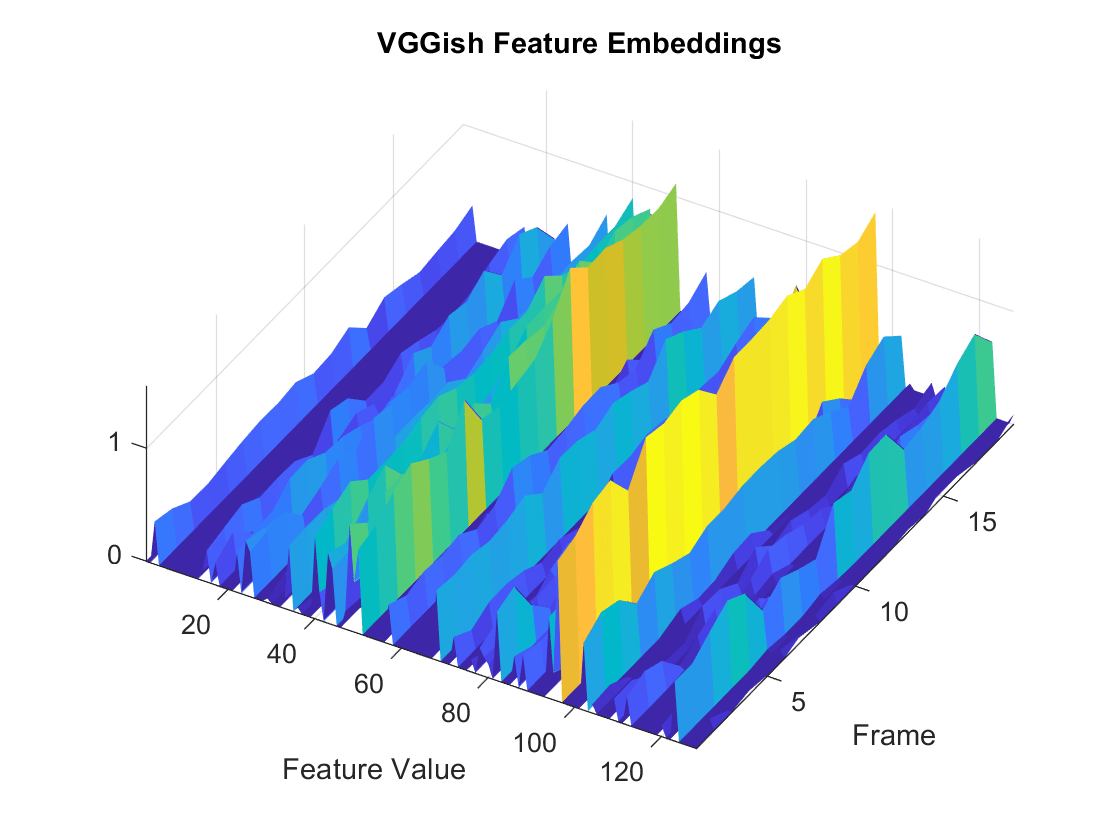
To increase the resolution of VGGish feature embeddings over time, specify the percent overlap between mel spectrograms. Plot the results.
overlapPercentage =75; embeddings = vggishEmbeddings(audioIn,fs,OverlapPercentage=overlapPercentage); surf(embeddings,EdgeColor="none") view([30 65]) axis tight xlabel("Feature Index") ylabel("Frame") zlabel("Feature Value") title("VGGish Feature Embeddings")

Read in an audio file, listen to it, and then extract VGGish feature embeddings from the audio. Using the vggishEmbeddings function requires installing the pretrained VGGish network. If the network is not installed, the function provides a link to download the pretrained model.
[audioIn,fs] = audioread("Counting-16-44p1-mono-15secs.wav");
sound(audioIn,fs)
embeddings = vggishEmbeddings(audioIn,fs);Visualize the VGGish feature embeddings over time. Many of the individual features are zero-valued and contain no useful information.
surf(embeddings,EdgeColor="none") view([90,-90]) axis tight xlabel("Feature Index") ylabel("Frame Index") title("VGGish Feature Embeddings")
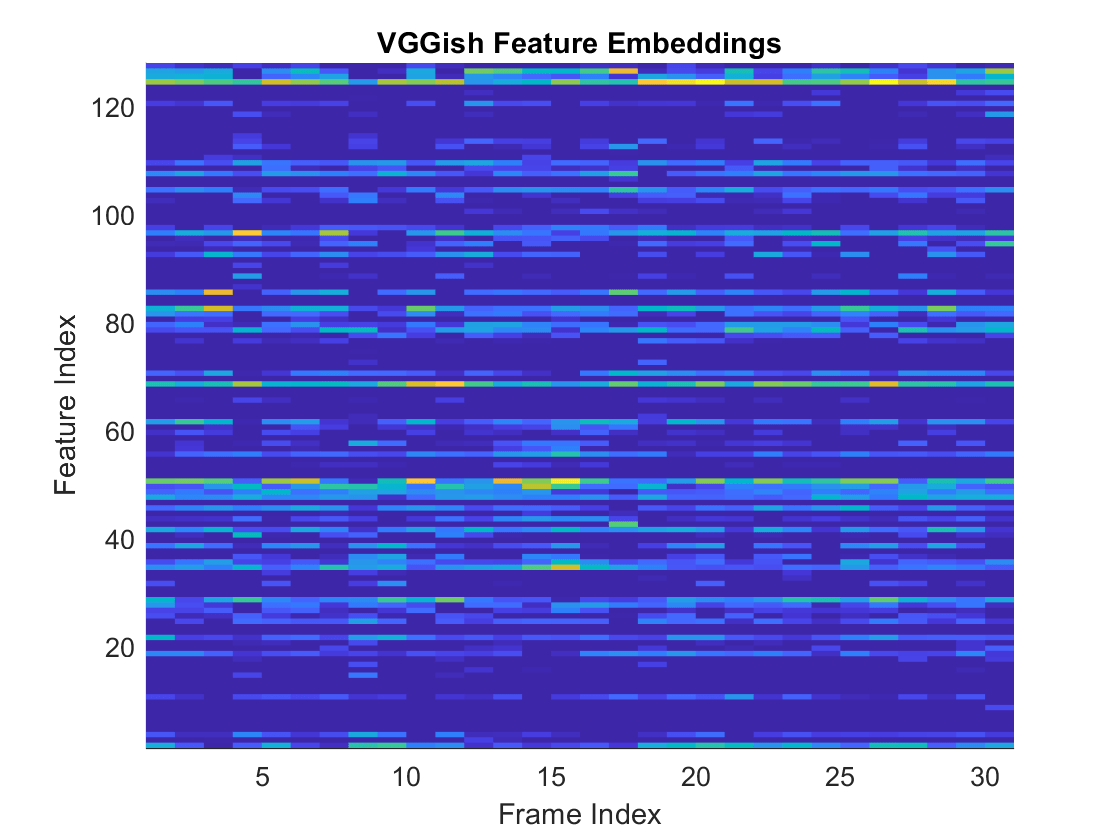
You can apply principal component analysis (PCA) to map the feature vectors into a space that emphasizes variation between the embeddings. Call the vggishEmbeddings function again and specify ApplyPCA as true. Visualize the VGGish feature embeddings after PCA.
embeddings = vggishEmbeddings(audioIn,fs,ApplyPCA=true); surf(embeddings,EdgeColor="none") view([90,-90]) axis tight xlabel("Feature Index") ylabel("Frame Index") title("VGGish Features + PCA")
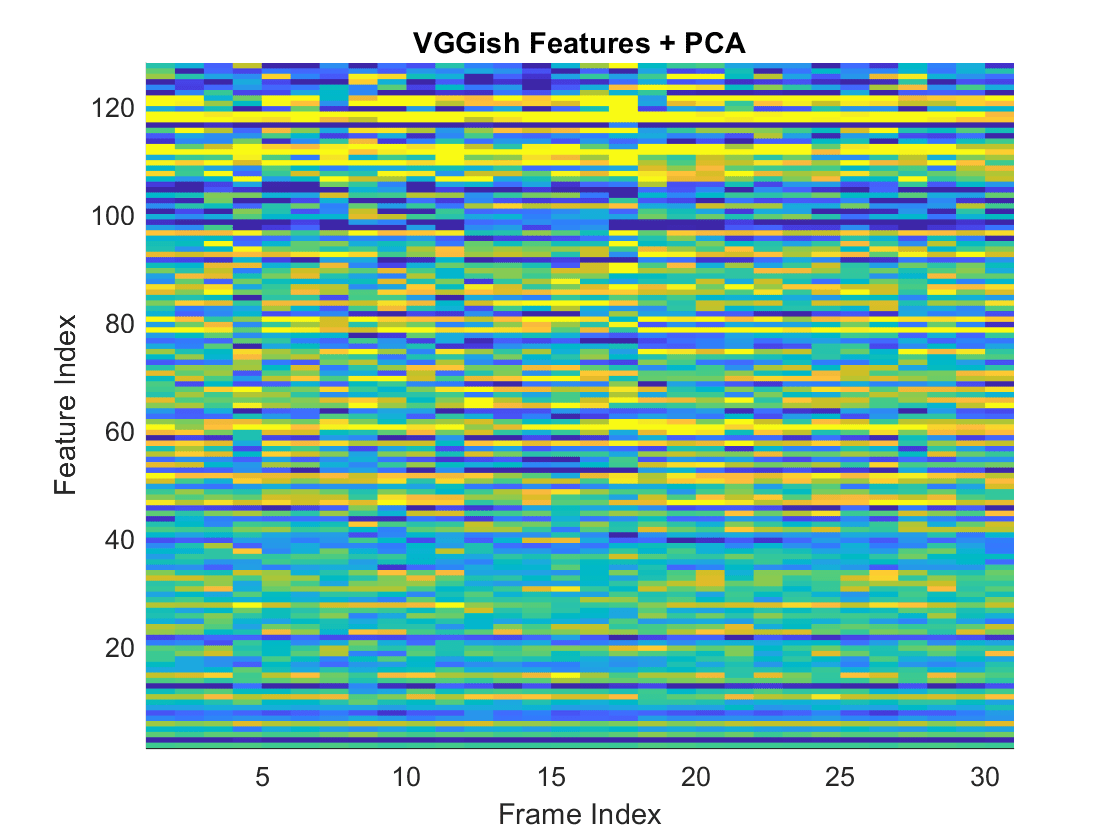
Download and unzip the air compressor data set. This data set consists of recordings from air compressors in a healthy state or in one of seven faulty states.
zipFile = matlab.internal.examples.downloadSupportFile("audio", ... "AirCompressorDataset/AirCompressorDataset.zip"); unzip(zipFile,tempdir) dataLocation = fullfile(tempdir,"AirCompressorDataset");
Create an audioDatastore object to manage the data and split it into training and validation sets.
ads = audioDatastore(dataLocation,IncludeSubfolders=true, ... LabelSource="foldernames"); [adsTrain,adsValidation] = splitEachLabel(ads,0.8);
Read an audio file from the datastore. Reset the datastore to return the read pointer to the beginning of the data set. Listen to the audio signal and plot the signal in the time domain.
[x,fileInfo] = read(adsTrain); fs = fileInfo.SampleRate; reset(adsTrain) sound(x,fs) figure t = (0:size(x,1)-1)/fs; plot(t,x) xlabel("Time (s)") title("State = " + string(fileInfo.Label)) axis tight

Extract VGGish feature embeddings from the training and validation sets. Using the vggishEmbeddings function requires installing the pretrained VGGish network. If the network is not installed, the function provides a link to download the pretrained model. There are multiple embeddings vectors for each audio file. Replicate the labels so that they are in one-to-one correspondence with the embeddings vectors.
trainFeatures = []; trainLabels = []; while hasdata(adsTrain) [audioIn,fileInfo] = read(adsTrain); features = vggishEmbeddings(audioIn,fileInfo.SampleRate, ... OverlapPercentage=75); numFeatureVecs = size(features,1); trainFeatures = cat(1,trainFeatures,features); trainLabels = cat(1,trainLabels,repelem(fileInfo.Label,numFeatureVecs)'); end classNames = unique(trainLabels); validationFeatures = []; validationLabels = []; segmentsPerFile = zeros(numel(adsValidation.Files), 1); idx = 1; while hasdata(adsValidation) [audioIn,fileInfo] = read(adsValidation); features = vggishEmbeddings(audioIn,fileInfo.SampleRate, ... OverlapPercentage=75); numFeatureVecs = size(features,1); validationFeatures = cat(1,validationFeatures,features); validationLabels = cat(1,validationLabels, ... repelem(fileInfo.Label,numFeatureVecs)'); segmentsPerFile(idx) = numFeatureVecs; idx = idx + 1; end
Define a simple network with two fully connected layers.
layers = [
featureInputLayer(128)
fullyConnectedLayer(32)
reluLayer
fullyConnectedLayer(8)
softmaxLayer];To define training options, use trainingOptions (Deep Learning Toolbox).
miniBatchSize = 128; options = trainingOptions("adam", ... MaxEpochs=20, ... MiniBatchSize=miniBatchSize, ... Shuffle="every-epoch", ... ValidationData={validationFeatures,validationLabels}, ... ValidationFrequency=50, ... Plots="training-progress", ... Metrics="accuracy", ... Verbose=false);
To train the network, use trainnet.
net = trainnet(trainFeatures,trainLabels,layers,"crossentropy",options)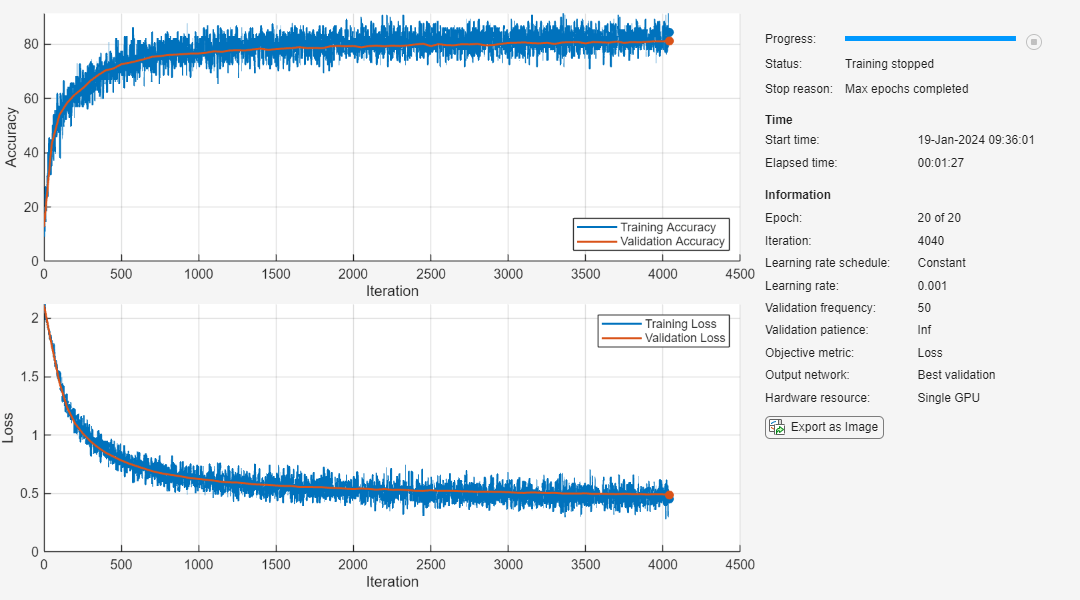
net =
dlnetwork with properties:
Layers: [5×1 nnet.cnn.layer.Layer]
Connections: [4×2 table]
Learnables: [4×3 table]
State: [0×3 table]
InputNames: {'input'}
OutputNames: {'softmax'}
Initialized: 1
View summary with summary.
Each audio file was split into several segments to feed into the network. Combine the predictions for each file in the validation set using a majority-rule decision.
scores = predict(net,validationFeatures); validationPredictions = scores2label(scores,classNames); idx = 1; validationPredictionsPerFile = categorical; for ii = 1:numel(adsValidation.Files) validationPredictionsPerFile(ii,1) = ... mode(validationPredictions(idx:idx+segmentsPerFile(ii)-1)); idx = idx + segmentsPerFile(ii); end
Visualize the confusion matrix for the validation set.
figure confusionchart(adsValidation.Labels,validationPredictionsPerFile, ... Title=sprintf("Confusion Matrix for Validation Data \nAccuracy = %0.2f %%", ... mean(validationPredictionsPerFile==adsValidation.Labels)*100))

Download and unzip the air compressor data set [1]. This data set consists of recordings from air compressors in a healthy state or in one of seven faulty states.
datasetZipFile = matlab.internal.examples.downloadSupportFile("audio","AirCompressorDataset/AirCompressorDataset.zip"); datasetFolder = fullfile(fileparts(datasetZipFile),"AirCompressorDataset"); if ~exist(datasetFolder,"dir") unzip(datasetZipFile,fileparts(datasetZipFile)); end
Create an audioDatastore object to manage the data and split it into training and validation sets.
ads = audioDatastore(datasetFolder,IncludeSubfolders=true,LabelSource="foldernames");In this example, you classify signals as either healthy or faulty. Combine all of the faulty labels into a single label. Split the datastore into training and validation sets.
labels = ads.Labels; labels(labels~=categorical("Healthy")) = categorical("Faulty"); ads.Labels = removecats(labels); [adsTrain,adsValidation] = splitEachLabel(ads,0.8,0.2);
Extract VGGish feature embeddings from the training set. Each audio file corresponds to multiple VGGish features. Replicate the labels so that they are in one-to-one correspondence with the features. Using the vggishEmbeddings function requires installing the pretrained VGGish network. If the network is not installed, the function provides a link to download the pretrained model.
trainFeatures = []; trainLabels = []; for idx = 1:numel(adsTrain.Files) [audioIn,fileInfo] = read(adsTrain); embeddings = vggishEmbeddings(audioIn,fileInfo.SampleRate); trainFeatures = [trainFeatures;embeddings]; trainLabels = [trainLabels;repelem(fileInfo.Label,size(embeddings,1))']; end
Train a cubic support vector machine (SVM) using fitcsvm (Statistics and Machine Learning Toolbox). To explore other classifiers and their performances, use Classification Learner (Statistics and Machine Learning Toolbox).
faultDetector = fitcsvm( ... trainFeatures, ... trainLabels, ... KernelFunction="polynomial", ... PolynomialOrder=3, ... KernelScale="auto", ... BoxConstraint=1, ... Standardize=true, ... ClassNames=categories(trainLabels));
For each file in the validation set:
Extract VGGish feature embeddings.
For each VGGish feature vector in a file, use the trained classifier to predict whether the machine is healthy or faulty.
Take the mode of the predictions for each file.
predictions = []; for idx = 1:numel(adsValidation.Files) [audioIn,fileInfo] = read(adsValidation); embeddings = vggishEmbeddings(audioIn,fileInfo.SampleRate); predictionsPerFile = categorical(predict(faultDetector,embeddings)); predictions = [predictions;mode(predictionsPerFile)]; end
Use confusionchart (Statistics and Machine Learning Toolbox) to display the performance of the classifier.
accuracy = sum(predictions==adsValidation.Labels)/numel(adsValidation.Labels);
cc = confusionchart(predictions,adsValidation.Labels);
cc.Title = sprintf("Accuracy = %0.2f %",accuracy*100);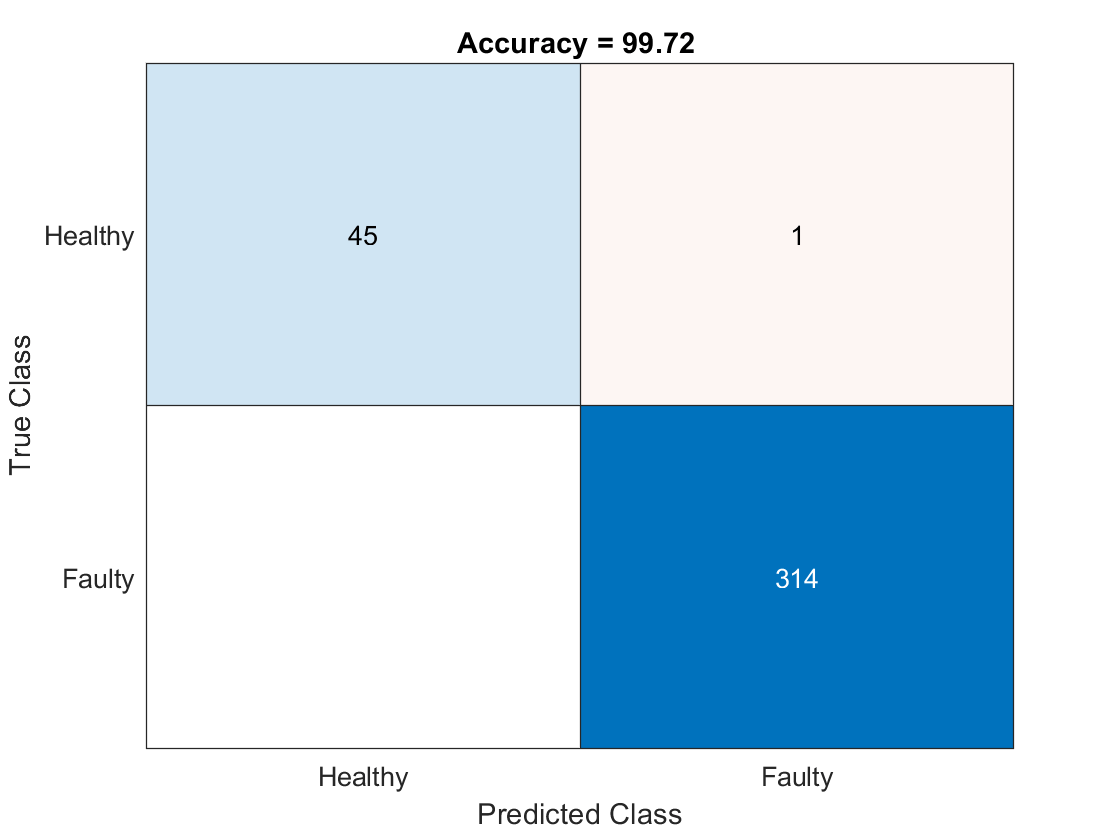
References
[1] Verma, Nishchal K., Rahul Kumar Sevakula, Sonal Dixit, and Al Salour. 2016. “Intelligent Condition Based Monitoring Using Acoustic Signals for Air Compressors.” IEEE Transactions on Reliability 65 (1): 291–309. https://doi.org/10.1109/TR.2015.2459684.
Input Arguments
Input signal, specified as a column vector or matrix. If you specify a matrix,
vggishEmbeddings treats the columns of the matrix as individual
audio channels.
The duration of audioIn must be equal to or greater than 0.975
seconds.
Data Types: single | double
Sample rate of the input signal in Hz, specified as a positive scalar.
Data Types: single | double
Name-Value Arguments
Specify optional pairs of arguments as
Name1=Value1,...,NameN=ValueN, where Name is
the argument name and Value is the corresponding value.
Name-value arguments must appear after other arguments, but the order of the
pairs does not matter.
Before R2021a, use commas to separate each name and value, and enclose
Name in quotes.
Example: OverlapPercentage=75
Percentage overlap between consecutive audio frames, specified as a scalar in the range [0,100).
Data Types: single | double
Flag to apply PCA transformation to audio embeddings, specified as either
true or false.
Data Types: logical
Output Arguments
Compact representation of audio data, returned as an L-by-128-by-N array, where:
L –– Represents the number of frames the audio signal is partitioned into. This is determined by the
OverlapPercentage.128 –– Represents the audio embedding length.
N –– Represents the number of channels.
Algorithms
The vggishEmbeddings function uses VGGish to extract feature
embeddings from audio. The vggishEmbeddings function preprocesses the
audio so that it is in the format required by VGGish and optionally postprocesses the
embeddings.
Resample
audioInto 16 kHz and cast to single precision.Compute a one-sided short time Fourier transform using a 25 ms periodic Hann window with a 10 ms hop, and a 512-point DFT. The audio is now represented by a 257-by-L array, where 257 is the number of bins in the one-sided spectra, and L depends on the length of the input.
Convert the complex spectral values to magnitude and discard phase information.
Pass the one-sided magnitude spectrum through a 64-band mel-spaced filter bank, then sum the magnitudes in each band. The audio is now represented by a single 64-by-L mel spectrogram.
Convert the mel spectrogram to a log scale.
Buffer the mel spectrogram into overlapped segments consisting of 96 spectra each. The audio is now represented by a 96-by-64-by-1-by-K array, where 96 is the number of spectra in the individual mel spectrograms, 64 is the number of mel bands, and the spectrograms are spaced along the fourth dimension for compatibility with the VGGish model. The number of mel spectrograms, K, depends on the input length and
OverlapPercentage.
Pass the 96-by-64-by-1-by-K array of mel spectrograms through VGGish to return a K-by-128 matrix. The output from VGGish are the feature embeddings corresponding to each 0.975 s frame of audio data.
If ApplyPCA is set to true, the feature
embeddings are postprocessed to match the postprocessing of the released AudioSet
embeddings. The VGGish model was released with a precomputed principal component analysis
(PCA) matrix and mean vector to apply a PCA transformation and whitening during inference.
The postprocessing includes applying PCA, whitening, and quantization.
Subtract the precomputed 1-by-128 PCA mean vector from the K-by-128 feature matrix, and then premultiply the result by the precomputed 128-by-128 PCA matrix.
Clip the transformed and whitened embeddings to between –2 and 2, then quantize the result to values that can be represented by
uint8.
References
[1] Gemmeke, Jort F., Daniel P. W. Ellis, Dylan Freedman, Aren Jansen, Wade Lawrence, R. Channing Moore, Manoj Plakal, and Marvin Ritter. 2017. “Audio Set: An Ontology and Human-Labeled Dataset for Audio Events.” In 2017 IEEE International Conference on Acoustics, Speech and Signal Processing (ICASSP), 776–80. New Orleans, LA: IEEE. https://doi.org/10.1109/ICASSP.2017.7952261.
[2] Hershey, Shawn, Sourish Chaudhuri, Daniel P. W. Ellis, Jort F. Gemmeke, Aren Jansen, R. Channing Moore, Manoj Plakal, et al. 2017. “CNN Architectures for Large-Scale Audio Classification.” In 2017 IEEE International Conference on Acoustics, Speech and Signal Processing (ICASSP), 131–35. New Orleans, LA: IEEE. https://doi.org/10.1109/ICASSP.2017.7952132.
Extended Capabilities
This function fully supports GPU arrays. For more information, see Run MATLAB Functions on a GPU (Parallel Computing Toolbox).
Version History
Introduced in R2022a
See Also
Apps
Blocks
Functions
MATLAB Command
You clicked a link that corresponds to this MATLAB command:
Run the command by entering it in the MATLAB Command Window. Web browsers do not support MATLAB commands.
Seleccione un país/idioma
Seleccione un país/idioma para obtener contenido traducido, si está disponible, y ver eventos y ofertas de productos y servicios locales. Según su ubicación geográfica, recomendamos que seleccione: .
También puede seleccionar uno de estos países/idiomas:
Cómo obtener el mejor rendimiento
Seleccione China (en idioma chino o inglés) para obtener el mejor rendimiento. Los sitios web de otros países no están optimizados para ser accedidos desde su ubicación geográfica.
América
- América Latina (Español)
- Canada (English)
- United States (English)
Europa
- Belgium (English)
- Denmark (English)
- Deutschland (Deutsch)
- España (Español)
- Finland (English)
- France (Français)
- Ireland (English)
- Italia (Italiano)
- Luxembourg (English)
- Netherlands (English)
- Norway (English)
- Österreich (Deutsch)
- Portugal (English)
- Sweden (English)
- Switzerland
- United Kingdom (English)